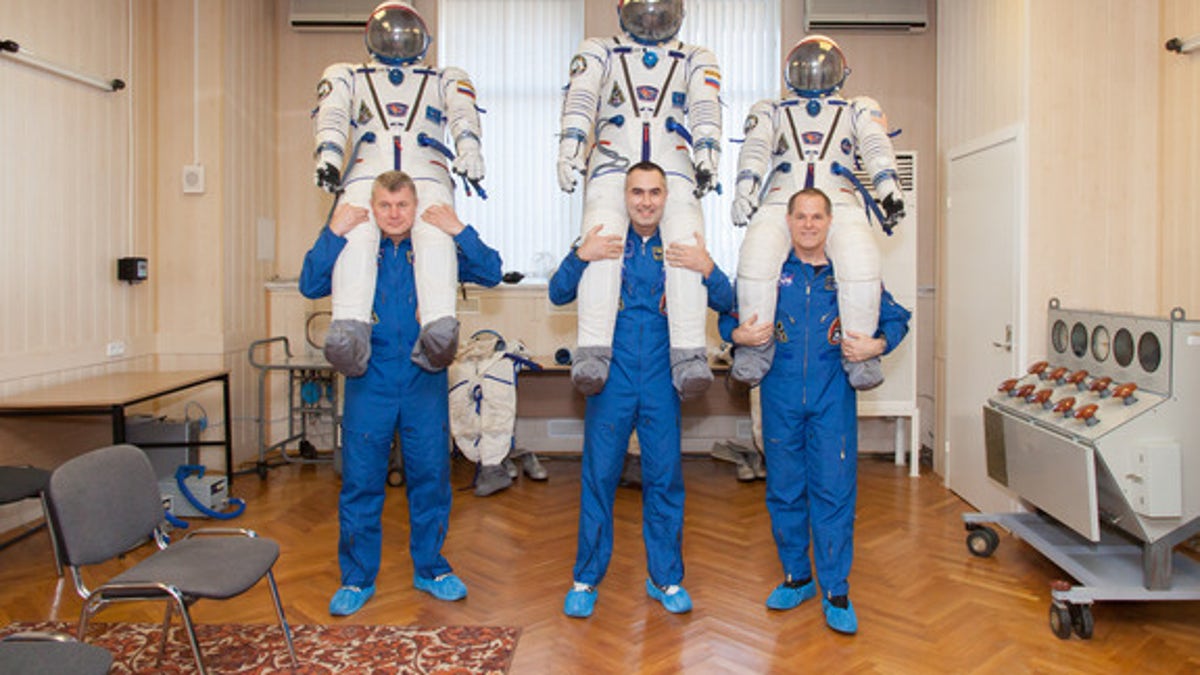
At the Baikonur Cosmodrome in Kazakhstan, the Expedition 33 crew share a playful moment Oct. 10, 2012 during the first of two so-called “fit check” dress rehearsal sessions. From left to right are Soyuz Commander Oleg Novitskiy, Flight Engineer (NASA/Victor Zelentsov)
Space travel may seem like a serious business, but it's not all work and no play for the next Russian-U.S. crew launching to the International Space Station.
With blast off just a few days away, the three-man team of cosmonauts Oleg Novitsky, Evgeny Tarelkin and American Kevin Ford are squeezing a bit of fun into their prelaunch work. A newly released photo of the space-bound trio captures one such moment: A crew portrait with each of the space men giving their Russian Sokol spacesuit a piggyback ride.
NASA called the scene a "playful moment" of crew bonding as the trio prepares to launch toward the International Space Station on Oct. 23. The cosmonauts and astronaut posed for the portrait during the first of two Sokol spacesuit fit checks ahead of their launch from Baikonur Cosmodrome in Kazakhstan. Photographer Victor Zelentsov took the snapshot on Oct. 10, with NASA featuring the image this week.
Sokol spacesuits are worn by crews of Russian Soyuz space capsules during launch and landing. Their name is Russian for "Falcon."
Novitsky, Tarelkin and Ford are the second half of the space station's Expedition 33 crew. They will join three other crewmates already aboard the station when they arrive at the orbiting laboratory on Oct. 25. The trio expects to spend about five months in space during their upcoming flight.
Ford is a veteran NASA space shuttle pilot and will ultimately take command of the space station's Expedition 34 mission when it begins later this year. Novitsky and Tarelkin are test cosmonauts each on their first career spaceflight.
NASA astronaut Sunita Williams currently commands the International Space Station's Expedition 33 crew. Flight engineers Yuri Malenchekno, of Russia, and Akihiko Hoshide of Japan round out the team. Williams, Malenchenko and Hoshide will return to Earth in mid-November, marking the transition from Expedition 33 to Expedition 34.
The International Space Station has been manned by astronaut and cosmonaut crews continuously since 2000, with construction of the $100 billion space laboratory beginning in 1998. Five different space agencies representing the United States, Russia, Europe, Canada and Japan have led the construction effort.
Today, the space station is the largest human-built structure in space. It is about the size of a football field and has the same living space as the cabin of a Boeing 747 jumbo jet. The space station can be seen easily from the ground by the unaided eye, if observers know where and when to look.
